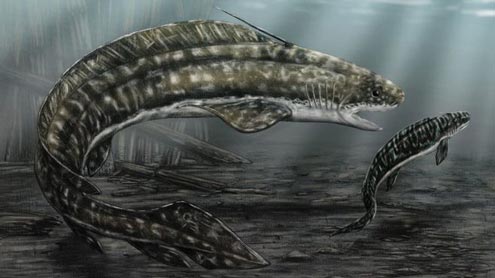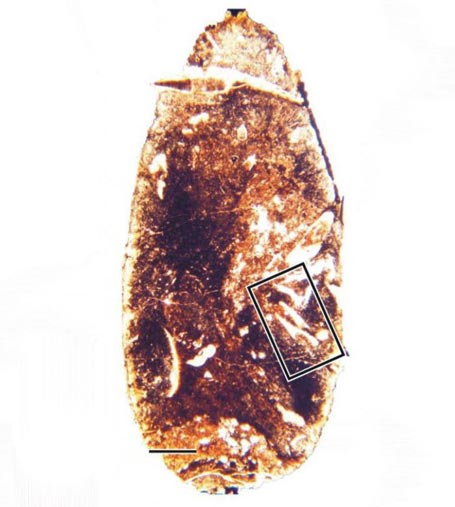Teeth in Coprolites Indicate Cannibalism in Orthacanthus
A study of the coprolites of a prehistoric, freshwater shark suggest that this fish indulged in cannibalism when times were hard. The shark in question, an Orthacanthus (identified from the typical spiral shape of the fossil poo), probably ate members of its own species when other food resources became scarce.
Carboniferous Sharks
During the Late Carboniferous, much of the Northern Hemisphere was covered by swamps and ancient forests. Amphibians and primitive reptiles dominated the land, but in the water, the fish reigned supreme and one group of fishes, that have survived through to today, the sharks, were particularly diverse and numerous.
Sharks not only dominated marine environments but they were also present in large numbers in brackish conditions and freshwater. One group of sharks, the Xenacanthiforms were very common in freshwater environments and Orthacanthus was a member of this group. Fossil coprolites found in the Minto Coalfield of New Brunswick, Canada, reveal a dark secret.
The 300-million-year-old shark poo is packed with the fossilised remains of juvenile members of its own genus. This is evidence of cannibalism, specifically fillial cannibalism – when adults of one species deliberately hunt and consume young of their own species, even their immediate offspring.
An Illustration of the Prehistoric Freshwater Shark Orthacanthus

An illustration of the prehistoric freshwater shark Orthacanthus, scientists have found evidence of cannibalism.
Picture credit: Alain Beneteau
Orthacanthus – A Freshwater Prehistoric Shark
A number of species of Orthacanthus shark have been described. These sharks, that possessed a long spine just in front of their sinewy dorsal fin, evolved in the Devonian. Orthacanthus fossils (especially teeth) are quite common in Carboniferous rocks located in North America and Europe. Orthacanthus teeth fossils have been found in Cumbria (UK), close to the small port of Whitehaven, a part of the coast we at Everything Dinosaur, know quite well.
The sediments in that part of Cumbria represent a coastal environment and amongst the carbonised remains of ancient plants, occasionally the distinctive tricuspid (three pointed) teeth of Orthacanthus can be found.
Cannibalism in Prehistoric Sharks
PhD student Aodhán Ó Gogáin (School of Natural Sciences, Trinity College Dublin, Ireland), one of the co-authors of the study that has been recently published in the journal of the Palaeontology Association “Palaeontology”, stated:
“Orthacanthus was a three-metre-long xenacanth shark with a dorsal spine, an eel-like body, and tricuspid teeth. There is already evidence from fossilised stomach contents that ancient sharks like Orthacanthus preyed on amphibians and other fish, but this is the first evidence that these sharks also ate the young of their own species.”
A Typical Shark Coprolite (note the spiralling)
Picture credit: Journal Palaeontology
For models and replicas of prehistoric animals: Prehistoric Animal Models.
Corkscrew Coprolite
Fossil shark poo (coprolite) is not rare, it can be found in quite plentiful quantities in some bedding planes. Shark coprolite comes in all shapes and sizes, but it often has a distinctive spiral pattern on it, an impression of the intestinal tract in which it was formed and of the rectum in which it was passed through. It is this spiral pattern that has permitted the scientists to identify the coprolite down to genus level in this instance.
Another co-author of the report, Dr Howard Falcon-Lang, of the Royal Holloway University of London commented:
“We don’t know why Orthacanthus resorted to eating its own young. However, the Carboniferous Period was a time when marine fishes were starting to colonise freshwater swamps in large numbers. It’s possible that Orthacanthus used inland waterways as protected nurseries to rear its babies, but then consumed them as food when other resources became scarce.”
Cannibalism Recorded in Extant Sharks
Fillial cannibalism has been observed in a number of extant shark species, including the Bull Shark (Carcharhinus leucas). The researchers suggest that Orthacanthus may have filled a similar environmental niche as modern Bull Sharks. Both types of shark are able to migrate backwards and forwards between salt and freshwater and in the case of Orthacanthus, this unusual adaptation for a fish may have helped it play an important role in the colonisation of inland freshwater environments.
A Polished Section of a Orthacanthus Coprolite with Juvenile Teeth Fragments Highlighted

A cross section of Orthacanthus coprolite with the fossilised teeth of a juvenile Orthacanthus indicated in the box.
Picture credit: Journal Palaeontology
In the picture above a cross section of a Orthacanthus coprolite shows tricuspid teeth of a juvenile preserved within the fossil poo (black box).
The scientific paper: “Fish and tetrapod communities across a marine to brackish salinity gradient in the Pennsylvanian (early Moscovian) Minto Formation of New Brunswick, Canada, and their palaeoecological and palaeogeographical implications”.
Visit Everything Dinosaur’s website: Everything Dinosaur.







[…] was a Cannibal (Link) Triceratops Against Concepts (Link) Vintage Dinosaur Art: Dinosaurs (The Open Gate Library) […]